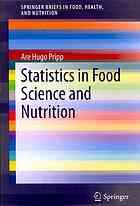

Most ebook files are in PDF format, so you can easily read them using various software such as Foxit Reader or directly on the Google Chrome browser.
Some ebook files are released by publishers in other formats such as .awz, .mobi, .epub, .fb2, etc. You may need to install specific software to read these formats on mobile/PC, such as Calibre.
Please read the tutorial at this link: https://ebookbell.com/faq
We offer FREE conversion to the popular formats you request; however, this may take some time. Therefore, right after payment, please email us, and we will try to provide the service as quickly as possible.
For some exceptional file formats or broken links (if any), please refrain from opening any disputes. Instead, email us first, and we will try to assist within a maximum of 6 hours.
EbookBell Team

4.4
22 reviewsMany statistical innovations are linked to applications in food science. For example, the student t-test (a statistical method) was developed to monitor the quality of stout at the Guinness Brewery and multivariate statistical methods are applied widely in the spectroscopic analysis of foods. Nevertheless, statistical methods are most often associated with engineering, mathematics, and the medical sciences, and are rarely thought to be driven by food science. Consequently, there is a dearth of statistical methods aimed specifically at food science, forcing researchers to utilize methods intended for other disciplines. The objective of this Brief will be to highlight the most needed and relevant statistical methods in food science and thus eliminate the need to learn about these methods from other fields. All methods and their applications will be illustrated with examples from research literature.